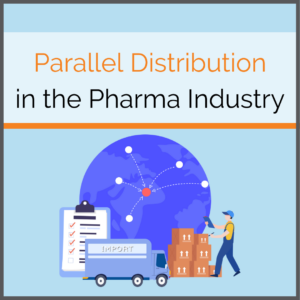
Despite the harmonization efforts of the European Falsified Medicines Directive, pharmaceutical regulations in the European Union remain fragmented. Belgium, France, Greece and Italy, for example, each have a national solution for the labeling of medicinal products that differ from those in other EU countries. A company manufacturing for Spain needs a lot more effort to export their products to Italy than to countries with a fully implemented EU FMD. One solution to this is parallel distribution.
However, this is not the only use of parallel distribution. As a key aspect of this industry, it is a practice that can significantly impact the accessibility and affordability of medicines. How does parallel distribution work? What are the benefits are? And how does it differs from parallel importation? These questions will be discussed in this article. The legal focus is on the European Union.
How does parallel distribution work?
The parallel distributor is an independent company that purchases medicinal products on foreign markets. Afterwards these products are places on different markets after repackaging. Parallel distribution refers to the trade of a medicinal product that has been authorized by a centralized procedure throughout the EU in accordance with Regulation (EC) No. 726/2004. A separate national authorization is not necessary. However, the “notification check” at the European Medicines Agency (EMA) must be completed before distribution.
After receiving an application for the notification check, the EMA examines it within 60 days. This is followed by either notification of approval for parallel distribution or a letter of non-compliance. Of the 60 days, 35 days are allocated to the Agency’s assessment, while the remaining 25 days are reserved for possible delays. The EMA carries out its assessment within 35 days from the date of the notification confirmation. If the conditions laid down in the EU legislation on medicinal products and in the marketing authorization are fulfilled, the parallel marketing authorization will be issued.
If there is an obstacle to issuing the authorization, the EMA will inform the parallel distributor. The 35-day period is then suspended until the parallel distributor responds to the Agency’s comments – but for a maximum of 25 days. In its response, the parallel trader is requested to consider any comments made by the EMA, to add or amend information and to adapt or explain the labeling or package leaflet.
The differences in parallel imports
With parallel imports, a company purchases a medicinal product from another EU or EEA (European Economic Area) member state and imports it. It is then distributed there “parallel” to the original pharmaceutical manufacturer.
The imported medicinal product is essentially identical to the original. In addition, there must be a valid national marketing authorization holder within the import country. Only manufacturers named in the marketing authorization may distribute the medicinal product. In contrast to parallel distribution, the parallel importer therefore requires its own national marketing authorization valid in the respective country.
However, the parallel importer usually does not have as much detailed information on the imported medicinal product as the original manufacturer. They are therefore unable to prepare a complete marketing authorization dossier and submit it to the relevant regulatory authority. Nevertheless, the imported medicinal product is already known to the relevant authority through the reference medicinal product. The parallel importer can therefore obtain a marketing authorization under the simplified procedure, in which only very limited information on the medicinal product is required.
What are the advantages?
Parallel importers and distributors play a crucial role in the pharmaceutical industry. They identify markets where medicines are sold at lower prices, purchase these medicines and then sell them in markets where prices are higher. This cost efficiency, as medicines are sourced from cheaper markets, benefits both distributors and consumers as medicines become more affordable. It also increases the availability of medicines, especially in countries with supply shortages. It also allows pharmaceutical companies to expand their market presence without incurring additional manufacturing or marketing costs.
What are the challenges?
Despite its advantages, parallel distribution is associated with several challenges. These include regulatory hurdles, as individual countries have different pharmaceutical regulations. There are also concerns about quality control and safety, as improper handling during distribution can affect the quality of medicines. Although prices are generally lower, parallel distribution can have an impact on pharma companies’ pricing strategies. For example, the price of frequently exported products may increase in the country of manufacture, with consequences for patients there.
The future of parallel distribution
The EU FMD exemption for Belgium, Greece and Italy will end on February 9, 2025. Due to the different requirements to the rest of the EU, parallel distribution and import was particularly pronounced there. Triggered by the changes, it is possible that there will be movement in the market and parallel distribution will lose some of its importance. Without the special regulations, it should be easier for manufacturers to produce directly for these target markets in the first place. However, it remains to be seen what the actual effects will be.
Parallel distribution is a crucial aspect of the pharmaceutical industry that has far-reaching implications for the accessibility and affordability of healthcare. While there are challenges, the potential benefits for consumers and the industry in general are immense.
Are you a parallel importer or distributor looking for a suitable solution for serializing your products? Feel free to contact us here.
[Disclaimer]
This information is only one possible interpretation of the regulations. They are also in a constant state of change, so the information in this article may be incomplete or out of date. The above article is expressly no legal advice. Please refer to the official documents for information before making any business decisions. (Status of information: July 2024)